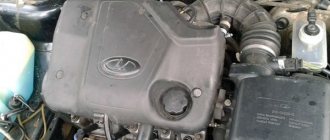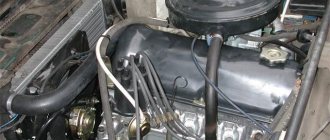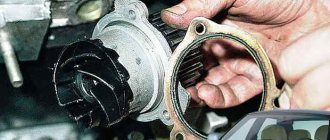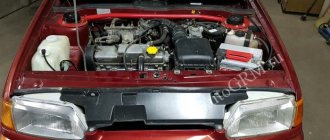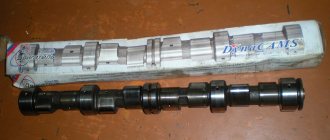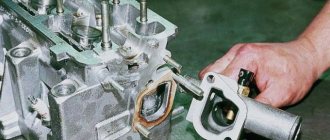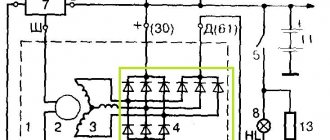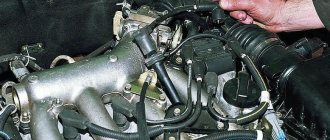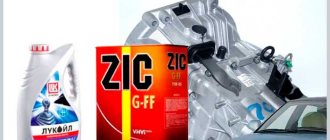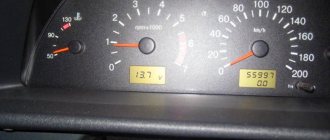“Fourteenth”, despite the fact that it has an outdated design, is still in demand by domestic drivers. Therefore, future owners of this car are interested in how much horsepower the VAZ 2114 has and which engine is best to get it with. Over its history, the car was produced with different types of power units of varying power. In this article we will tell you what engines this car was produced with, and also analyze their strengths and weaknesses, fuel consumption and acceleration.
8 valve engine 1.6
The 1.6-liter engine with 8 valves also began to be installed in 2003, that is, from the first years of production. The last such “four” rolled off the assembly line in 2013. Fans of the model are interested in how much horsepower the VAZ 2114 (8 valves) has with an engine of this size.
This power unit has a power of 89 horses . It is slightly more powerful than a 1.5 liter engine. But it is advisable to use AI-95 gasoline for it.
True, many owners fill in AI-92, which does not harm the car at all. The car is very economical. In the combined cycle, its fuel consumption is about 7.5 liters per hundred kilometers. And it accelerates to 100 km/h in 13 seconds. Since 2010, AvtoVAZ began installing an electronic gas pedal on this modification. But this innovation was not warmly received by all car enthusiasts. Fuel injection has also been improved in connection with new environmental standards. Fans of the model also have an ambivalent attitude towards this change.
Interior
In the interior decoration of the fourteenth model, the designers miscalculated a little with the materials. For example, the fabric used for seat upholstery wore out after just a couple of years of active use, which is why drivers always had to use covers. The hard plastic used in the control panel begins to creak strongly in the cold, which causes some inconvenience to the car's passengers.
There is no need to mention the sound insulation of the VAZ 2114 - there is practically none in the car. Meanwhile, the interior of the hatchback is compact and laconic. All control devices are located near the driver. The center console is even turned in his direction for convenience. In front of the front passenger there is only a glove box and a niche for small items.
The cabin capacity is four adults. And only of average height. It will be extremely uncomfortable for tall people in the back seat: firstly, the low ceiling will interfere, and secondly, there is too little distance between the rows of seats for knees.
The main convenience of this hatchback is the folding rear row of seats. By folding it, the driver will receive increased luggage space.
16 valve engine 1.6 (SuperAuto)
Not everyone knows, but 2114 also has a special SuperAuto series. A small number of these cars were produced. They are distinguished by improved driving performance and dynamic characteristics.
Under the hood of this car there is a 1.6-liter engine with 16 valves. It produces a power of as much as 92 hp , which is quite good for this model. Combined with the light weight of the car, this made it much faster. The car accelerates to 100 km/h in 11.2 seconds.
AI-95 fuel is recommended for this engine. But some drivers use AI-92. For a hundred kilometers, such a car requires approximately 7.2 liters of gasoline.
Exterior
The appearance of the VAZ 2114 is not for everyone. Just like in the “ninth” family, “square body shapes” predominate here. A lot of broken lines completely deprived the car of grace, but added confidence and its own style to its appearance. The car has a large glass area, which provides the driver with good all-round visibility.
It is noteworthy that the VAZ 2114 is the only model of a domestic manufacturer whose door opening angle is 90 degrees. Agree, not every foreign car can boast of such convenience.
The front part of the “fourteenth” is expressed by large rectangular headlights, divided into two sections, a miniature radiator grille that provides the necessary volume of air to cool the power plant, and a neat bumper.
The wheel arches of the car look compact and appropriate: 13-inch wheels fit well into them. On later editions, the manufacturer provided 14-inch wheels.
Among the attractive exterior features are aggressive optics and short aerodynamic overhangs, which give the car good dynamic characteristics. The only inconvenience is the small side mirrors, which provide insufficient visibility to the driver. Special indignation is caused by door handles with a “tongue” that periodically does not allow the driver to enter the car.
The body of the fourteenth model consists of more than half of galvanized steel, the use of which was supposed to give the car anti-corrosion resistance. However, the hatchback did not receive this quality. As a result, drivers, in order to maintain the integrity of the car, have to periodically treat it with anticorrosive. Otherwise, through corrosion will very quickly render the vehicle unusable.
Fuel consumption
Hatchbacks of this model are known for their efficiency. They consume little fuel, both on the highway and in the city. We invite you to compare the gasoline consumption of the VAZ 2114 for modifications with different types of power plants.
| Engine | Highway consumption l/100 km | Mixed mode, l/100 km | Urban cycle, l/100 km |
| 1.5l, 8-valve | 5,7 | 7,3 | 10,0 |
| 1.6l, 8-valve | 6 | 7,5 | 10,3 |
| 1.6 l, 16 valve | 5,4 | 7,2 | 9,8 |
Summarize
LADA Samara was popular in the early 2000s due to its low cost, maintainability and novelty. They bought it because... It was difficult to find a foreign analogue in good condition. However, now there are no problems with competitors - they are all available in abundance on the secondary market. It’s hard to say what makes car enthusiasts buy domestic “fourteeners”. Possibly savings. Perhaps a desire to support AvtoVAZ.
However, in any case, when purchasing this car, it is worth remembering that it is no different in safety and reliability. And it is better to give preference to foreign competitors in which manufacturers have invested at least minimal options to ensure safe movement. Especially if you plan to use the vehicle to transport passengers. Savings are not appropriate here.
Source
Acceleration to 100 km/h
Thanks to the light weight of the body, with its modest power data, the car turned out to be quite nimble. Even with the weakest power unit, it accelerates to 100 km/h quite quickly. The table presents comparative acceleration data for cars with different types of engines.
| Engine | Acceleration to 100 km/h, s |
| 1.5l, 8-valve | 13,2 |
| 1.6l, 8-valve | 13 |
| 1.6 l, 16 valve | 11,2 |
Tuning an injector with 8 valves
To increase power from 77 to 96 horsepower of the very first engine of the VAZ-2111 model, you need to do:
- boring valve seats along the inner diameter;
- boring the channel necks for installing duralumin plates and loosening the springs by 1.5 millimeters;
- replacing standard valves with lightweight ones;
- recessing of guide bushings from special brass;
- installation of a split timing gear;
- use of imported valve cotters;
- installation of a narrow-phase shaft.
The tuning shaft has an inlet of 70 degrees and an outlet of 66. Its opening angles are 250 and 246 degrees, respectively. After completing the work, it is necessary to install the engineering firmware and carefully configure the motor parameters. Only in this case, after all sensors are turned on, the engine will start working normally.
It is better to use a split gear on non-plug-in motors. For installation, it is necessary to carry out the work in almost the same way as when replacing the timing belt, that is, apply marks, disassemble the mechanism, and align the crankshaft. After installing the new gear, pay attention to the 4th cylinder. If the valves in it are not open to the maximum, in this case you will need to loosen the outer screws and adjust the camshaft, after which you need to tighten the fasteners.
Which engine is better?
Each of the engines of this car has its own disadvantages and advantages. Therefore, it is difficult to answer this question unambiguously.
The 1.5 liter engine has little power, but it is reliable and unpretentious. The power unit is not demanding on fuel quality. If the timing belt breaks, the valve does not bend. A common problem with such power units is belt slippage. If you don't take care of it, it can be damaged by the rollers. The 1.6-liter 8-valve engine slightly added power to the car. But at the same time, gasoline consumption has also increased. This engine is the most uneconomical among those installed on the VAZ 2114. At the same time, it is reliable and durable. In cars with an electronic gas pedal, according to some motorists, slower acceleration is possible. But perhaps this is due to driving style and other factors. The 16-valve 1.6-liter engine is considered the most progressive and powerful in the line. He gave the “fourteenth” a significant increase in power and excellent dynamics. At the same time, fuel consumption has also decreased. This engine needs good maintenance and better fuel. If the timing belt breaks, the valves may bend. This is an unpleasant feature of the power unit.
Pros and cons of the VAZ 2114
Having studied the given tables listing the main indicators of the car, it is worth noting the main positive and negative aspects of the “four”. Taking into account the price of used cars on the secondary market, there is no need to talk about serious shortcomings of the car.
At the moment, the combination of efficiency, cheap spare parts and maintainability in the fourteenth model is the best on the secondary market in many cities. Let's start by considering the advantages of the second generation Samar:
- Low price on the secondary market. A “live” copy can be purchased for 70-90 thousand rubles;
- Engine reliability. With a fairly average level of maintenance, most units can last from 150,000 to 250,000 kilometers without major repairs;
- Availability of “European panel”. On-board computer, electric windows, heated front seats, fabric door trim - all this is available in the “luxury” configuration;
- A good ground clearance of 165 millimeters is suitable for Russian roads.
The disadvantages of the second generation “Samar” are due to the use of fairly average quality materials from plastic, metal and components. More about the disadvantages:
- High susceptibility to corrosion. The first thing that suffers is the wheel arches and fenders. Also a “disease” is the lower edge of the trunk lid. Power elements are more durable, but are also subject to deep corrosion after 7-9 years;
- Poor quality interior plastic. Creaks and rattles of the panel in the “four” are commonplace. The problem is solved by gluing the interior with sound insulation;
- Weak gearbox. Second gear crunching is a constant problem. An incorrectly selected gear ratio on the box leads to rapid wear of the synchronizers;
- Low level of security. The lack of airbags, ABS systems, directional stability, and hill descent assistance - all this makes driving a car more difficult.
Over time, these shortcomings turn into serious problems. For trouble-free use, it is recommended to purchase a car with a low mileage of up to 120,000 kilometers and no more than ten years old.
